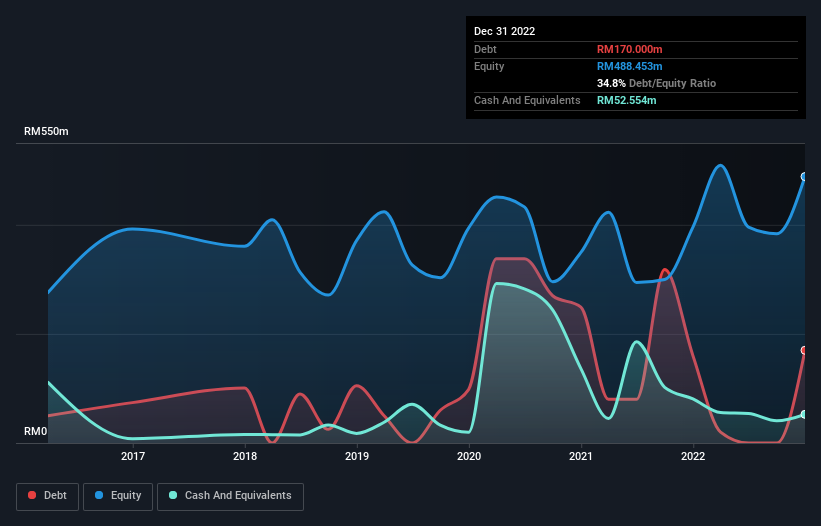Heineken Malaysia Berhad (KLSE:HEIM) Has A Rock Solid Balance Sheet

Howard Marks put it nicely when he said that, rather than worrying about share price volatility, 'The possibility of permanent loss is the risk I worry about... and every practical investor I know worries about.' So it might be obvious that you need to consider debt, when you think about how risky any given stock is, because too much debt can sink a company. We can see that Heineken Malaysia Berhad (KLSE:HEIM) does use debt in its business. But should shareholders be worried about its use of debt?
When Is Debt A Problem?
Debt assists a business until the business has trouble paying it off, either with new capital or with free cash flow. Ultimately, if the company can't fulfill its legal obligations to repay debt, shareholders could walk away with nothing. While that is not too common, we often do see indebted companies permanently diluting shareholders because lenders force them to raise capital at a distressed price. Of course, the upside of debt is that it often represents cheap capital, especially when it replaces dilution in a company with the ability to reinvest at high rates of return. When we think about a company's use of debt, we first look at cash and debt together.
View our latest analysis for Heineken Malaysia Berhad
What Is Heineken Malaysia Berhad's Net Debt?
The image below, which you can click on for greater detail, shows that at December 2022 Heineken Malaysia Berhad had debt of RM170.0m, up from RM160.1m in one year. However, it also had RM52.6m in cash, and so its net debt is RM117.4m.

A Look At Heineken Malaysia Berhad's Liabilities
We can see from the most recent balance sheet that Heineken Malaysia Berhad had liabilities of RM890.3m falling due within a year, and liabilities of RM37.3m due beyond that. Offsetting these obligations, it had cash of RM52.6m as well as receivables valued at RM630.3m due within 12 months. So its liabilities outweigh the sum of its cash and (near-term) receivables by RM244.7m.
Given Heineken Malaysia Berhad has a market capitalization of RM8.19b, it's hard to believe these liabilities pose much threat. Having said that, it's clear that we should continue to monitor its balance sheet, lest it change for the worse. But either way, Heineken Malaysia Berhad has virtually no net debt, so it's fair to say it does not have a heavy debt load!
In order to size up a company's debt relative to its earnings, we calculate its net debt divided by its earnings before interest, tax, depreciation, and amortization (EBITDA) and its earnings before interest and tax (EBIT) divided by its interest expense (its interest cover). The advantage of this approach is that we take into account both the absolute quantum of debt (with net debt to EBITDA) and the actual interest expenses associated with that debt (with its interest cover ratio).
Heineken Malaysia Berhad has a low net debt to EBITDA ratio of only 0.17. And its EBIT easily covers its interest expense, being 346 times the size. So you could argue it is no more threatened by its debt than an elephant is by a mouse. On top of that, Heineken Malaysia Berhad grew its EBIT by 84% over the last twelve months, and that growth will make it easier to handle its debt. There's no doubt that we learn most about debt from the balance sheet. But ultimately the future profitability of the business will decide if Heineken Malaysia Berhad can strengthen its balance sheet over time. So if you want to see what the professionals think, you might find this free report on analyst profit forecasts to be interesting.
But our final consideration is also important, because a company cannot pay debt with paper profits; it needs cold hard cash. So we clearly need to look at whether that EBIT is leading to corresponding free cash flow. Over the most recent three years, Heineken Malaysia Berhad recorded free cash flow worth 61% of its EBIT, which is around normal, given free cash flow excludes interest and tax. This free cash flow puts the company in a good position to pay down debt, when appropriate.
Our View
Heineken Malaysia Berhad's interest cover suggests it can handle its debt as easily as Cristiano Ronaldo could score a goal against an under 14's goalkeeper. And that's just the beginning of the good news since its EBIT growth rate is also very heartening. Overall, we don't think Heineken Malaysia Berhad is taking any bad risks, as its debt load seems modest. So we're not worried about the use of a little leverage on the balance sheet. The balance sheet is clearly the area to focus on when you are analysing debt. But ultimately, every company can contain risks that exist outside of the balance sheet. Case in point: We've spotted 2 warning signs for Heineken Malaysia Berhad you should be aware of.
Of course, if you're the type of investor who prefers buying stocks without the burden of debt, then don't hesitate to discover our exclusive list of net cash growth stocks, today.
Valuation is complex, but we're here to simplify it.
Discover if Heineken Malaysia Berhad might be undervalued or overvalued with our detailed analysis, featuring fair value estimates, potential risks, dividends, insider trades, and its financial condition.
Access Free AnalysisHave feedback on this article? Concerned about the content? Get in touch with us directly. Alternatively, email editorial-team (at) simplywallst.com.
This article by Simply Wall St is general in nature. We provide commentary based on historical data and analyst forecasts only using an unbiased methodology and our articles are not intended to be financial advice. It does not constitute a recommendation to buy or sell any stock, and does not take account of your objectives, or your financial situation. We aim to bring you long-term focused analysis driven by fundamental data. Note that our analysis may not factor in the latest price-sensitive company announcements or qualitative material. Simply Wall St has no position in any stocks mentioned.
About KLSE:HEIM
Heineken Malaysia Berhad
Produces, packages, markets, and distributes alcoholic beverages primarily in Malaysia.
Proven track record with adequate balance sheet and pays a dividend.
Market Insights
Community Narratives




